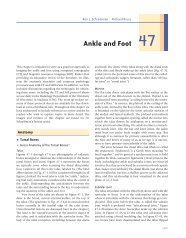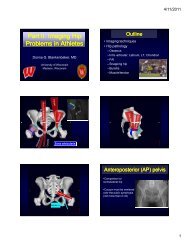CT Arthrography (CTR)
CT Arthrography (CTR)
CT Arthrography (CTR)
Create successful ePaper yourself
Turn your PDF publications into a flip-book with our unique Google optimized e-Paper software.
Lecouvet and coworkers (Eur Radiol 2007; 17:1763-1771), <strong>CT</strong>R sensitivity for high<br />
grade (full thickness and deep partial thickness) cartilage lesions of the glenohumeral<br />
joint was 89-96% and specificity was 98%.<br />
<strong>CT</strong>R has an advantage in detecting calcified forms of pathology, including calcific<br />
tendonitis and the Bennett lesion, which is a posterior enthesophyte in throwers with<br />
posterior instability. <strong>CT</strong>R may be especially useful in the postoperative patient, when<br />
metal suture anchors in a repaired labrum or rotator cuff may create too much artifact on<br />
MR scans. Of course, bioabsorbable anchors do not present the same drawbacks, and<br />
tiny micro-metallic debris usually is not a significant detractor from MR imaging of the<br />
shoulder. Intraarticular fragments are probably equally detected with most modalities.<br />
Anatomic bone deformities, such as glenoid hypoplasia and Hill Sachs impaction<br />
fractures, should be sought on <strong>CT</strong>R.<br />
ELBOW<br />
Technical Considerations: At our facility, the elbow is seldom studied with either MRR<br />
or <strong>CT</strong>R. Injecting the joint is usually a straightforward procedure. The patient is either<br />
prone with the upper extremity extended over the head and flexed at the elbow, or the<br />
patient can be sitting on a stool with the elbow flat on the exam table and flexed 90<br />
degrees, with the lateral aspect directed toward the ceiling. The key step in this process is<br />
angling the fluoroscopy tube to profile the lateral elbow joint appropriately, with no<br />
overlap of the radial head and capitulum. Once the fluoro tube is aligned, minimal skin<br />
anesthesia is necessary for this superficial joint. After that, a 1.5 inch 25-gauge<br />
anesthesia needle is more than enough to reach the joint. Target the anterior half of the<br />
joint.<br />
If the patient can fully extend the elbow, and there is not limiting shoulder pain, it is best<br />
to scan the elbow with the patient prone and the arm fully extended overhead, with full<br />
extension of the elbow. In that position, a single axial volume of data can be reformatted<br />
into axial, sagittal, and coronal planes. If the elbow must be flexed, it is best to achieve<br />
90 degrees flexion if possible, making the planes as orthogonal as possible. If the arm<br />
cannot go above the head for the short scanning time, it must be placed at the patient’s<br />
side. This will introduce additional beam hardening artifact from the torso in the<br />
scanning field.<br />
Findings and Indications: <strong>CT</strong>R of the elbow has been promoted for the detection of<br />
intra-articular fragments (“loose bodies”). The elbow is a frequent victim of intraarticular<br />
fragments, despite the fact that it is not a weight bearing joint. These bodies<br />
often limit motion and cause pain. However, the utility of <strong>CT</strong>R in finding these lesions<br />
remains in question. In a recent article in the British version of the Journal of Bone &<br />
Joint Surgery, <strong>CT</strong>R did not show a significant advantage over MRI or even radiographs!

















